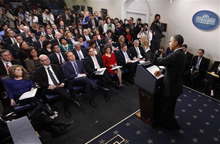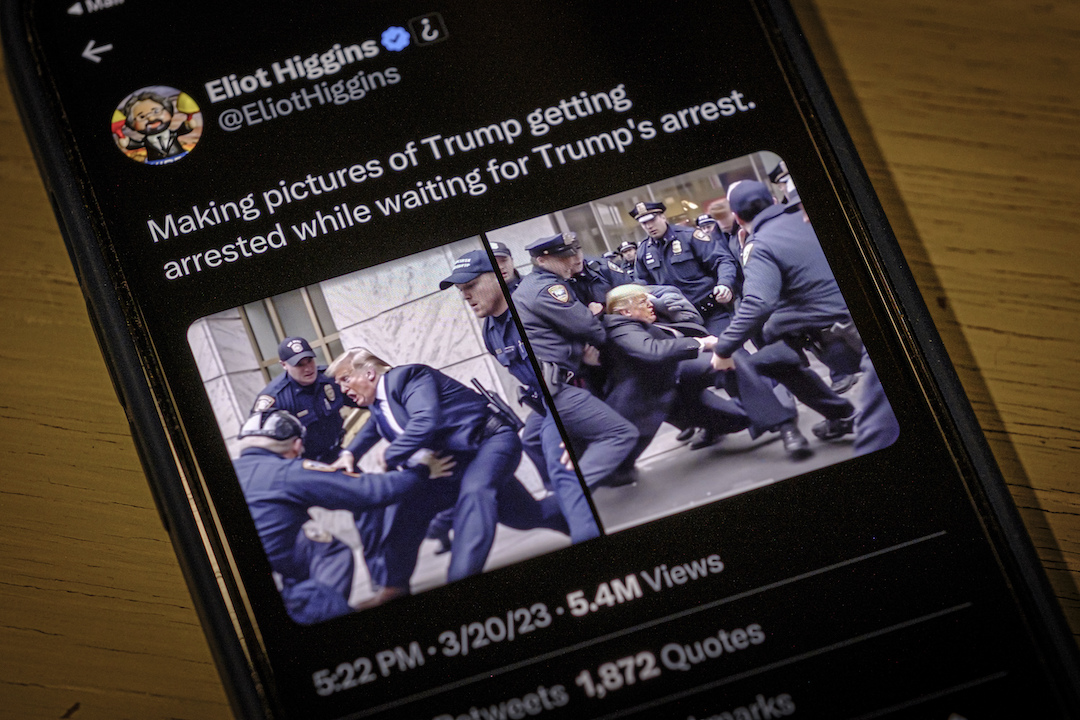The White House press corps became a story this week, which is almost always bad news.
In a piece entitled “Obama the puppet master,” Politico reported that the Obama Administration had put media manipulation “on steroids.” It was using social media and technology in new ways to bypass the press and target access. By doing so, the White House had embarked on a “transformational” path that tipped power “unmistakably toward government.”
What’s really occurring, however, is something less novel but actually more important — and it may be making our leaders less honest and less credible.
Presidents and the press
Presidents have grumped about reporters since Thomas Jefferson complained about the licentiousness of the press in 1809. And every competent president has adopted the newest technology to bypass them, from Roosevelt talking directly to Americans on radio in the 1930s, to Clinton using satellite hookups with local TV reporters.
Martha Kumar of Towson University in Maryland has studied presidential communications for decades; she recalled this week that when Dwight Eisenhower’s people broke the ban on allowing television cameras in press conferences — the disruptive technology of the 1950s — Ike’s press secretary Jim Haggerty wrote in his diary: “To hell with slanted reporters. We’ll go directly to the people….”
Politico suggested this week that Obama is shutting out traditional media in favor of social media, direct communication and by issuing official images from the White House photographer (a job launched a half century ago). The numbers say something else. Obama granted 674 interviews to reporters in his first term — the most of any president on record, according to Kumar’s records.
| Interviews by 1st Term Presidents | |
| Barack Obama | 674 |
| George H. W. Bush | 382 |
| Ronald Reagan | 243 |
| George W. Bush | 217 |
| Bill Clinton | 191 |
What has changed is the calculus about where to spend the effort. Most of these 674 interviews were with local TV reporters (a Clinton era specialty, though one Reagan and both Bush’s experimented with, too). As Michael Calderone pointed out, Obama has not given a one-on-one interview to The New York Times since 2010 or to The Washington Post since 2009. His network interviews are usually with “60 Minutes,” where he is granted more time and reaches a significantly bigger audience (about 11 million viewers).
Obama isn’t simply dodging tough questions in favor of softballs from out-of-town neophytes. The more salient fact is presidents get more bang from these interviews in a crowded media environment.
One of the eight stations that interviewed Obama this week, KFOR from Oklahoma City, has a 10-minute interview it plans to run for several days, with pieces on every one of the station’s shows, Kumar found. That will have more impact in that market than any national media hit. Obama also has targeted exactly how the budgetary showdown over sequestration will affect people in Oklahoma.
And the lawyerly president, Kumar argues, is better at longer interviews than the short Q&A format of White House photo ops. Consider he recently did a 50-minute press conference and only answered eight questions.
Media management models
In classic press management, there are two basic approaches. At one end of the spectrum is the “Conduit Model” in which newsmakers use the press (or their technology) as a vehicle to deliver messages. The other is the “Constituent Model” in which officials and aides try to woo and persuade reporters that their case is just.
Republicans historically lean more toward the conduit end of the spectrum and Democrats toward the constituent (though skilled and underfunded insurgents in all parties — think John McCain or Newt Gingrich — tend to lean constituent).
All presidents, however use both models. The only distinction is where they land on the spectrum.
More technologies exist today for presidents to deliver messages directly. And it is easier and more efficient to target local media. All this pushes officials closer to the conduit end of the press management spectrum.
Press secretaries see changes
“When I was there some of this would have been considered government propaganda,” George W. Bush’s first press secretary Ari Fleischer said in an interview. “That seems a quaint notion now.”
But the greater number of tools for direct messaging is where the risk comes in. The old media are hardly irrelevant. And there are some significant limitations to using social media, bypass and direct messaging. Facebook followers and email subscribers are not the American public whose minds you need to change. They are your supporters. The Web remains more a tool for organizing than persuasion.
“The Obama team has used digital technology fairly effectively to organize during the campaign but it has not figured out how, or if you can, govern using it,” Kumar observed. They have particularly stumbled at creating a sustained narrative.
More importantly, lost in the discussion of technology is something significant about honesty and government. This is what concerns two former press secretaries who were among the most successful at the job.
“One of the most dangerous consequences of the Obama media strategy [of avoiding the White House press corps] is that it allows the president and other high officials to believe they can speak, or even mislead with impunity,” said Marlin Fitzwater, who was press secretary for both Presidents George H.W. Bush and Ronald Reagan.
Fitzwater said in an email interview that he doesn’t believe the president would make such statements as “we don’t have a spending problem” or “we are the most transparent administration in history” if “he believed he would be personally questioned about his meaning.”
Even writers sympathetic to the president, such as Matt Miller, this week have gagged over the absurdity of some of the sequestration rhetoric.
Former Clinton press secretary Mike McCurry shares the concern that respect for the press is a form of respecting the public’s right to know. “Both sides in this adversarial relationship suffer when there is not some relationship of basic trust,” some recognition each has a job to do and so should do it professionally, McCurry emailed.
“Public briefings at the White House need to be about public information, not spin. White House reporting needs to be about reporting hard news on what the President is up to, not endless analysis and opinion.”
Dangerous delusions
In other words, it is a self-defeating delusion for government officials to think they can force feed and bypass the press that covers them each day. It is also a delusion for the press to think it is a singular gatekeeper. Both delusions, in turn, hurt the public. A president is less effective and less persuasive who doesn’t seriously engage with the toughest and most knowledgeable White House reporters.
Presidents certainly must now communicate directly in the digital space. Their opponents surely will, and that will only grow. That is one reason why this is not a shift simply toward government control.
But even in a competitive media environment, the reporters following you every day are not a constituency serving only their own interests. They are also responding to their sense of broad public concern and asking questions they imagine their communities want to hear. And precisely because they are a kind of adversary, the White House reporters who bear witness to a President’s actions offer a reality check to the one thing all leaders are most vulnerable to — the polarizing isolation of listening only to those who agree with them.
Correction: Ronald Reagan did 243 interviews in his first year as president, not 273 as this story originally said.
Tom Rosenstiel is Executive Director of the American Press Institute, an author, journalist and a member of Poynter’s National Advisory Board. You can follow him on Twitter @tbr1.








Comments